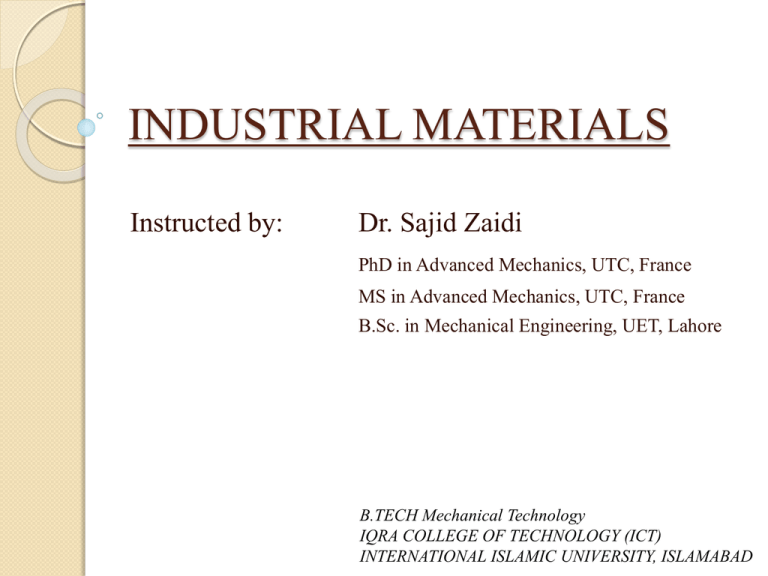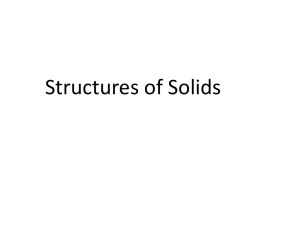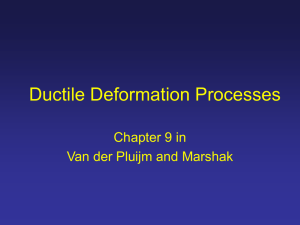INDUSTRIAL MATERIALS - B Tech Mechanical Engineering
advertisement

INDUSTRIAL MATERIALS
Instructed by:
Dr. Sajid Zaidi
PhD in Advanced Mechanics, UTC, France
MS in Advanced Mechanics, UTC, France
B.Sc. in Mechanical Engineering, UET, Lahore
B.TECH Mechanical Technology
IQRA COLLEGE OF TECHNOLOGY (ICT)
INTERNATIONAL ISLAMIC UNIVERSITY, ISLAMABAD
Crystal Geometry
INDUSTRIAL MATERIALS
(a) Inert monoatomic gases
have no regular ordering of
atoms
(b,c) Some materials,
including water vapor,
nitrogen gas, amorphous
silicon and silicate glass
have short-range order
(d) Metals, alloys, many
ceramics and some
polymers have regular
ordering of atoms/ions that
extends through the
material
(a,b,c) non-dense, random packing,
(d) dense, regular packing
Concept of Crystal Geometry
Space Lattice
INDUSTRIAL MATERIALS
Crystal Geometry
Atomic arrangements in crystalline solids can be
described by referring the atoms to the points of
intersection of a network of lines in three dimensions.
Such a network is called a space lattice.
It can be described as an infinite three-dimensional array
of points.
Each space lattice can be described by specifying the
atom positions in a repeating unit cell.
The unit cell is the subdivision of a lattice that still
retains the overall characteristics of the entire lattice.
Concept of Crystal Geometry
Unit Cell
INDUSTRIAL MATERIALS
Crystal Geometry
The basic structural unit of a crystal structure.
Its geometry and atomic positions define the crystal
structure.
A unit cell is the smallest component of the crystal that
reproduces the whole crystal when stacked together with
purely translational repetition.
By stacking identical unit
cells, the entire lattice can be
constructed.
Concept of Crystal Geometry
INDUSTRIAL MATERIALS
Crystal Geometry
Lattice Parameters
The lattice parameters include
◦ Dimensions of the sides of the unit cell
◦ Angles between the sides
◦ The length is often given in nanometers
(nm) or Angstrom (Å) units, where:
1 angstrom (Å) = 0.1 nm = 10-10 m = 10-8 cm
Concept of Crystal Geometry
Crystal System
INDUSTRIAL MATERIALS
Crystal Geometry
There are 7 unique arrangements of the unit cell that
define the crystal system
Axes
Angle b/w axes
Volume of unit cell
Cubic
a=b=c
α = β = γ = 90º
a3
Tetragonal
a=b≠c
α = β = γ = 90º
a2c
Orthorhombic
a≠b≠c
α = β = γ = 90º
abc
Concept of Crystal Geometry
INDUSTRIAL MATERIALS
Crystal Geometry
Crystal System
Axes
Angle b/w axes
Volume of unit cell
Rhombohedral
a=b=c
α = β = γ ≠ 90º
a3(13cos2α+2cos3α)1/2
Monoclinic
a≠b≠c
α = β = 90º, γ ≠ 90º
abc sinγ
Triclinic
a≠b≠c
α ≠ β ≠ γ ≠ 90º
Hexagonal
a=b≠c
abc (1-cos2α-cos2βcos2γ+2cosαcosβcosγ)1/2
α = β = 90º, γ = 120º
3*0.866a2c
Concept of Crystal Geometry
INDUSTRIAL MATERIALS
Crystal Geometry
Bravais Lattices
Lattice points are located at the corners of the unit cells
and, in some cases, at either faces or the center of the
unit cell.
14 distinct arrangements of lattice points are possible.
These unique arrangements of lattice points are known
as the Bravais lattices.
Concept of a lattice is mathematical and does not
mention atoms, ions or molecules.
One or more atoms can be associated with each lattice
point
Bravais Lattices
INDUSTRIAL MATERIALS
Crystal Geometry
Concept of Crystal Geometry
Concept of Crystal Geometry
INDUSTRIAL MATERIALS
Crystal Geometry
Atomic Radius vs Lattice Parameters
a0 = 2r
a0√3 = 4r
a0√2 = 4r
Concept of Crystal Geometry
INDUSTRIAL MATERIALS
Crystal Geometry
No. of Atoms per Unit Cell
The number of atoms per unit cell is the product of the
number of atoms per lattice point and the number of
lattice points per unit cell.
In most metals, one atom is located at each lattice point.
A unit cell has specific number of lattice points:
◦ at each corner of the cell
◦ at center of the cell (in case of body-centered)
◦ at each face of the cell (in case of face-centered)
It must be noticed that one lattice point may be shared
by more than one unit cell.
Concept of Crystal Geometry
INDUSTRIAL MATERIALS
Crystal Geometry
No. of Atoms per Unit Cell
A lattice point at a corner of one unit cell is shared by
seven adjacent unit cells (thus a total of eight cells); only
one-eighth of each corner lattice point belongs to one
particular cell.
Similarly, a lattice point at the
face of one unit cell is shared by
one adjacent unit cells (thus a
total of two cells); only one-half
of each face lattice point belongs
to one particular cell.
Concept of Crystal Geometry
No. of Atoms per Unit Cell
INDUSTRIAL MATERIALS
Crystal Geometry
Number of total corner lattice points in a unit cell is
◦ (Total number of corners) x (lattice point per corner)
= 8 x 1/8 = 1
Number of total body-centered lattice points in a unit
cell is
◦ (Total number of centers) x (lattice point per center)
= 1x1=1
Number of total face-centered lattice points in a unit cell
is
◦ (Total number of faces) x (lattice point per face)
= 6 x 1/2 = 3
Concept of Crystal Geometry
Coordination Number
INDUSTRIAL MATERIALS
Crystal Geometry
The coordination number is the number of atoms
touching a particular atom, or the number of nearest
neighbors for that particular atom.
Simple Cubic
Concept of Crystal Geometry
INDUSTRIAL MATERIALS
Crystal Geometry
Packing Factor
The packing factor is the fraction of space occupied by
atoms, assuming that atoms are hard spheres sized so
that they touch their closest neighbor. The general
expression for the packing factor is:
Packing factor = (number of atoms/cell) x (volume of each
atom) / (volume of unit cell)
Packing Factor of SC = 0.52
No commonly encountered engineering metals or alloys
have the SC structure, although this structure is found in
ceramic materials.
Principle Metallic Crystal Structures
INDUSTRIAL MATERIALS
Crystal Geometry
Most elemental metals (about 90 percent) crystallize
upon solidification into three densely packed crystal
structures:
a) Body-Centered Cubic (BCC)
b) Face-Centered Cubic (FCC)
c) Hexagonal Close-Packed (HCP)
Principle Metallic Crystal Structures
INDUSTRIAL MATERIALS
Crystal Geometry
Most metals crystallize in these dense-packed
structures because energy is released as the atoms
come closer together and bond more tightly with
each other. Thus, the densely packed structures are
in lower and more stable energy arrangements.
Simple Cubic
Face-Centered Cubic
Body-Centered Cubic
Hexagonal Close-Packed
a0√3 = 4r
INDUSTRIAL MATERIALS
Crystal Geometry
Body-Centered Cubic (BCC)
Hard Sphere Unit Cell
Isolated Unit Cell
Number of atoms in a unit cell of BCC = 2
Coordination number = 8
Packing Factor = 0.68
That is, 68 percent of the volume of the BCC unit cell is
occupied by atoms and the remaining 32 percent is empty
space.
The BCC crystal structure is not 100% close-packed structure
since the atoms could be packed closer together.
Body-Centered Cubic (BCC)
INDUSTRIAL MATERIALS
Crystal Geometry
Many metals such as iron, chromium, tungsten,
molybdenum, and vanadium have the BCC crystal
structure at room temperature.
Metals with mixed bonding, such as iron, may have unit
cells with less than the maximum packing factor.
Selected metals that have the BCC Crystal Structure at room temperature (20◦C)
and their Lattice Constants and Atomic Radii
INDUSTRIAL MATERIALS
Crystal Geometry
Face-Centered Cubic (FCC)
Hard Sphere Unit Cell
a0√2 = 4r
Isolated Unit Cell
Number of atoms in a unit cell of FCC = 4
Coordination number = 12
Packing Factor = 0.74
That is, 74 percent of the volume of the BCC unit cell is
occupied by atoms and the remaining 26 percent is
empty space.
Face-Centered Cubic (FCC)
INDUSTRIAL MATERIALS
Crystal Geometry
The PF of 0.74 is for the closest packing possible of
“spherical atoms.”
Many metals such as aluminum, copper, lead, nickel,
and iron at elevated temperatures (912 to 1394◦C)
crystallize with the FCC crystal structure.
Metals with only metallic bonding are packed as
efficiently as possible.
Selected metals that have the FCC Crystal Structure at room temperature (20◦C)
and their Lattice Constants and Atomic Radii
Hexagonal Close-Packed (HCP)
Metals do not crystallize into the simple hexagonal
crystal structure because the PF is too low.
The atoms can attain a lower energy and a more stable
condition by forming the HCP structure.
The PF of the HCP crystal structure is 0.74, the same as
that for the FCC crystal structure since in both structures
the atoms are packed as tightly as possible.
INDUSTRIAL MATERIALS
Crystal Geometry
Hard Sphere Unit Cell
Isolated Unit Cell
Hexagonal Close-Packed (HCP)
INDUSTRIAL MATERIALS
Crystal Geometry
The HCP has six atoms per unit cell.
◦ Three atoms form a triangle in the middle layer.
◦ There are six 1/6 atom sections on both the top and bottom
layers, making an equivalent of two more atoms (2 × 6 ×
1/6 = 2).
◦ Finally, there is one-half of an atom in the center of both
the top and bottom layers making the equivalent of one
more atom.
◦ The total number of atoms in the HCP crystal structure unit
cell is thus 3 + 2 + 1 = 6.
Hexagonal Close-Packed (HCP)
Coordination number is 12.
The ratio of the height c of the hexagonal prism of the HCP
crystal structure to its basal side a is called the c/a ratio.
The c/a ratio for an ideal HCP crystal structure consisting of
uniform spheres packed as tightly together as possible is
1.633.
INDUSTRIAL MATERIALS
Crystal Geometry
Selected metals that have the HCP Crystal Structure at room temperature (20◦C)
and their Lattice Constants, Atomic Radii and c/a ratios
Hexagonal Close-Packed (HCP)
Cadmium and zinc have c/a ratios higher than ideality,
which indicates that the atoms in these structures are
slightly elongated along the c axis of the HCP unit cell.
The metals magnesium, cobalt, zirconium, titanium, and
beryllium have c/a ratios less than the ideal ratio.
Therefore, in these metals the atoms are slightly
compressed in the direction along the c axis.
Thus, for the HCP metals listed in the table, there is a
certain amount of deviation from the ideal hard-sphere
model.
INDUSTRIAL MATERIALS
Crystal Geometry
Atom Positions in Cubic Unit Cells
To locate atom positions in
z
cubic unit cells, rectangular
(0,1,1)
(0,0,1)
x, y, and z axes are used.
In crystallography the
(1,1,1)
(1,0,1)
positive x axis is usually
the direction coming out of
the paper, the positive y
(0,1,0)
axis is the direction to the
(0,0,0)
right of the paper, and the
y
(1,0,0)
positive z axis is the
(1,1,0)
direction to the top.
x
Negative directions are
(1/2,1/2,1/2)
opposite to those just
described.
Body – Centered Cubic (BCC)
INDUSTRIAL MATERIALS
Crystal Geometry
Atom Positions in Cubic Unit Cells
INDUSTRIAL MATERIALS
Crystal Geometry
z
(0,0,0)
y
x
Face – Centered Cubic (FCC)
Directions in Cubic Unit Cells
INDUSTRIAL MATERIALS
Crystal Geometry
Directions in crystal lattices are especially important for
metals and alloys with properties that vary with
crystallographic orientation.
z
Direction of OS
Coordinates of S - Coordinates of O
(1,1,0) – (0,0,0) = (1,1,0) = [110]
Position coordinates of direction
vector OS
O
y
S
x
Direction indices of direction
vector OS
Directions in Cubic Unit Cells
INDUSTRIAL MATERIALS
Crystal Geometry
Some directions in cubic unit cell
Significance of Crystallographic Directions
Metals deform more easily, for example, in directions
along which atoms are in closest contact.
Another real-world example is the dependence of the
magnetic properties of iron and other magnetic materials
on the crystallographic directions.
It is much easier to magnetize iron in the [100] direction
compared to [111] or [110] directions. This is why the
grains in Fe-Si steels used in magnetic applications are
oriented in the [100] or equivalent directions.
In the case of magnetic materials used for recording
media, we have to make sure the grains are aligned in a
particular crystallographic direction such that the stored
information is not erased easily. Similarly, crystals used
for making turbine blades are aligned along certain
directions for better mechanical properties.
INDUSTRIAL MATERIALS
Crystal Geometry
INDUSTRIAL MATERIALS
Crystal Geometry
Planes in Cubic Unit Cells
Sometimes it is necessary to refer to specific lattice
planes of atoms within a crystal structure, or it may be
of interest to know the crystallographic orientation of a
plane or group of planes in a crystal lattice.
Metals deform easily along planes of atoms that are
most tightly packed together.
The surface energy of different faces of a crystal
depends upon the particular crystallographic planes.
This becomes important in crystal growth. In thin film
growth of certain electronic materials (e.g., Si or GaAs),
we need to be sure the substrate is oriented in such a
way that the thin film can grow on a particular
crystallographic plane.
To identify crystal planes in cubic crystal structures, the
Miller notation system is used.
Miller Indices
INDUSTRIAL MATERIALS
Crystal Geometry
The Miller indices of a crystal plane are defined as the
reciprocals of the fractional intercepts (with fractions
cleared) that the plane makes with the crystallographic
x, y, and z axes of the three nonparallel edges of the
cubic unit cell.
The procedure for determining the Miller indices for a
cubic crystal plane is as follows:
1.
2.
3.
4.
Choose a plane that does not pass through the origin at (0, 0,
0).
Determine the intercepts of the plane in terms of the
crystallographic x, y, and z axes for a unit cube. These
intercepts may be fractions.
Form the reciprocals of these intercepts.
Clear fractions and determine the smallest set of whole
numbers that are in the same ratio as the intercepts. These
whole numbers are the Miller indices of the crystallographic
plane and are enclosed in parentheses
INDUSTRIAL MATERIALS
Crystal Geometry
Miller Indices
Some examples
Miller Indices
INDUSTRIAL MATERIALS
Crystal Geometry
In cubic crystal structures the interplanar spacing
between two closest parallel planes with the same Miller
indices is designated dhkl , where h, k, and l are the
Miller indices of the planes. This spacing represents the
distance from a selected origin containing one plane and
another parallel plane with the same indices that is
closest to it.
From simple geometry,
it can be shown that for
cubic crystal structures
dhkl =
a
S
√h2 + k2 + l2
Crystallographic Planes in Hexagonal
Unit Cells
Crystal planes in HCP unit cells are commonly
identified by using four indices, Miller-Bravais indices,
instead of three.
These are denoted by the letters h, k, i, and l and are
enclosed in parentheses as (hkil).
These four-digit hexagonal indices are based on a
coordinate system with four axes
There are three basal axes, a1,
a2, and a3, which make 120◦ with
each other.
The fourth axis or c axis is the
vertical axis located at the center
of the unit cell.
INDUSTRIAL MATERIALS
Crystal Geometry
Crystallographic Planes in Hexagonal
Unit Cells
INDUSTRIAL MATERIALS
Crystal Geometry
The a unit of measurement along the a1, a2, and a3 axes
is the distance between the atoms along these axes.
The unit of measurement along the c axis is the height of
the unit cell.
The reciprocals of the intercepts that a crystal plane
makes with the a1, a2, and a3 axes give the h, k, and i
indices, while the reciprocal of the intercept with the c
axis gives the l index.
Crystallographic Planes in Hexagonal
Unit Cells
Basal Planes
As the basal plane on the top of
the HCP unit cell is parallel to a1,
a2, and a3, the intercepts of this
plane with these axes will all be
infinite. Thus, a1 = ∞, a2 = ∞, and a3 = ∞.
The c axis is unity since the top basal plane intersects
the c axis at unit distance.
Taking the reciprocals of these intercepts gives the
Miller-Bravais indices for the HCP basal plane. Thus h =
0, k = 0, = 0, and l = 1. The HCP basal plane is,
therefore, a zero-zero-zero-one or (0001) plane.
INDUSTRIAL MATERIALS
Crystal Geometry
Crystallographic Planes in Hexagonal
Unit Cells
Prism Planes
The intercepts of the front prism
Plane (ABCD) are a1 = +1, a2 = ∞,
a3 = −1, and c = ∞. Taking the
reciprocals of these intercepts gives
h = 1, k = 0, i = −1, and l = 0, or the (1010) plane.
The ABEF prism plane has the indices (1100) and the
DCGH plane the indices (0110).
All HCP prism planes can be identified collectively as
the {1010} family of planes.
INDUSTRIAL MATERIALS
Crystal Geometry
Expected Questions
INDUSTRIAL MATERIALS
Crystal Geometry
Calculate the packing factor for the SC, BCC and FCC.
Calculate the percent volume change as zirconia (ZrO2)
transforms from a tetragonal to a monoclinic structure.
The lattice constants for the monoclinic unit cells are: a
=5.156Å, b=5.191Å, c=5.304Å , and the angle β is
98.9º. The lattice constants for the tetragonal unit cell
are a=5.094Å and c=5.304Å. Does the zirconia expand
or contract during this transformation?
Draw [121] direction and (210) plane in a cubic unit
cell.
Iron at 20ºC is BCC with atoms of atomic radius 0.124
nm. Calculate the lattice constant a for the cube edge of
the iron unit cell.
Expected Questions
INDUSTRIAL MATERIALS
Crystal Geometry
Calculate the volume of the zinc crystal structure unit
cell by using the following data: pure zinc has the HCP
crystal structure with lattice constants a = 0.2665 nm
and c = 0.4947 nm.
Draw the following direction vectors in cubic unit cells:
◦ [100], [110], [112], [110], [321]
Draw the following crystallographic planes in cubic unit
cells:
◦ (101), (110), (221)
◦ Draw a (110) plane in a BCC atomic-site unit cell, and list the
position coordinates of the atoms whose centers are intersected
by this plane.







